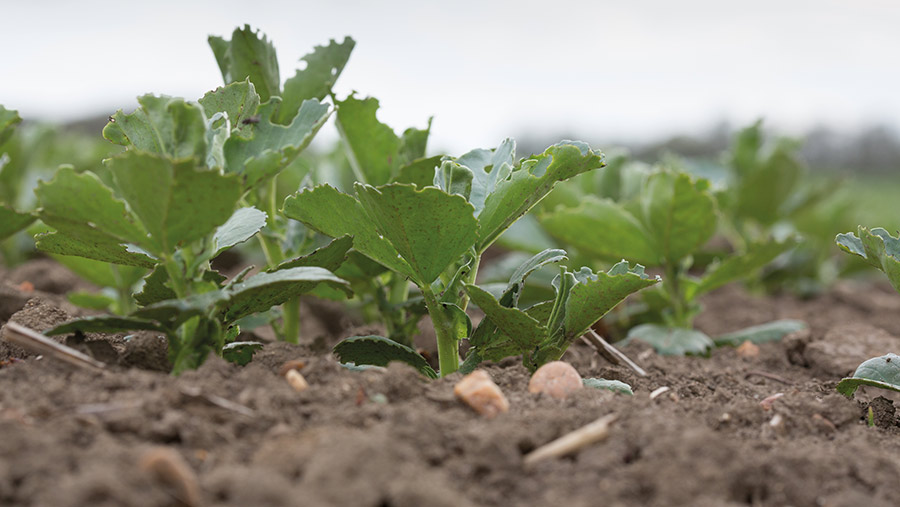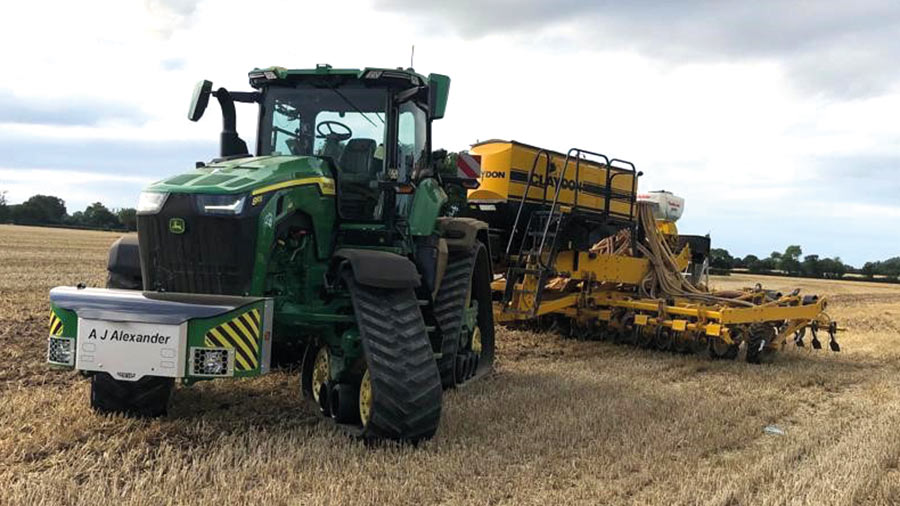Beans make reliable and low-input break crop for arable farm
 © Tim Scrivener
© Tim Scrivener Norfolk grower Rob Alexander has turned to winter and spring beans as more reliable low-input break crops.
He finds the crop much less risky than oilseed rape and causes less soil damage during harvest than vining peas.
His winter bean area is increasing and he drilled 113ha of the crop in excellent conditions in autumn 2022.
His five-year average yield is 5t/ha-plus, with variable costs of only £300/ha, and he says beans are simply more predictable than other break crops.
Beans are the ideal break crop on some of his heavier land, and moving to establishing the crop by direct drilling has helped improve the structure of his soils.
Moving as little soil as possible has limited any large flushes of weeds in the following spring.
“Beans are less cash-hungry than oilseed rape. OSR is incredibly hungry up front, whereas beans are the reverse,” he tells Farmers Weekly.
See also: Farmers join forces to grow high-yield low-cost spring beans
Farm facts
- Farming and contracting business – A J Alexander & Son, Bush Green Farm, Pulham Market, Diss, Norfolk
- Farms 1,450ha for 12 landowners within a 10-mile radius across six different soil types
- Grows 12 crops – winter wheat, winter barley, spring barley, oilseed rape, winter and spring beans, sugar beet, vining peas, parsley, grass, and cover and catch crops
- Soils are mainly medium, but range from sand through sandy clay loams to heavier clays
Drilling date
Winter beans are drilled in late October, sprayed with a pre-emergence herbicide and largely left until the spring.
Oilseed rape, on the other hand, needs almost constant attention to monitor the threat from cabbage stem flea beetles and pigeons, and often requires several expensive herbicide applications.
Mr Alexander’s bean crops are giving gross margins of just over £1,000/ha, less than the best oilseed rape can deliver, but they are consistent.
In contrast, rapeseed crops can be lost due to flea beetle attacks and dry weather at establishment.
The bean crops also compare well with vining peas, since pea harvesting can easily damage the soil structure in a wet summer, and pea prices are currently facing downward pressure.
Therefore, beans have gained in area over oilseed rape and vining peas on the 1,450ha Mr Alexander’s family farms at Bush Green Farm, Pulham Market, covering owned, tenanted and contracted land.
The oilseed rape area has reduced on his heavier land due largely to flea beetle damage and the need to control blackgrass and other weeds.
In its place this season’s beans got off to a flying start in the warm autumn soil, adhering to the old bean adage of “well sown, well grown”.
“The beans look amazing – I am really pleased with the crop this season,” he says.
Successful establishment
Mr Alexander adds the ideal time to drill his winter bean crop is the last week of October, or even a little earlier,.
He has been successfully establishing the crop with a Claydon 6m tined drill for the past four seasons, which has seen a big improvement compared with using other drills.
Beans often follow winter wheat in his heavy land rotation, so land is stubble raked or given a very light shallow cultivation to encourage a weed flush, then sprayed off with glyphosate to get it ready for the drill.
The variety Tundra is drilled at 100mm depth to keep the beans well out of the way of raiding rooks at an average seed rate of 210kg/ha. This rate can be increased slightly on heavier land.
Mr Alexander says the Claydon drill works well as it loosens the soil lower than the seed, allowing for good rooting and establishment.
The key is not to let the soil get too wet so it causes smearing of the drill slot, he says.
The move to direct drilling has given a very level seed-bed, which allows Mr Alexander to harvest the crop with a low combine bed to help gather all the low-lying bean pods.
The Claydon is turning on undisturbed soil on the headlands, which helps with yields at these field ends.

© Rob Alexander
Maintenance-free crop
The only autumn treatment is a pre-emergence herbicide spray of pendimethalin and propyzamide (Kerb), as Mr Alexander emphasises the crop is virtually “maintenance-free” compared with oilseed rape.
His land often gets farmyard manure elsewhere in the rotation, but 80% of the bean land gets a top-up of potash, magnesium and sulphur just when the crop starts to grow in the spring.
Winter crops normally get two fungicide sprays at early flowering in mid-April and late flowering in mid-May for the control of chocolate spot, although a third spray is sometimes needed.
Last year, this was tebuconazole, followed by tebuconazole + azoxystrobin (Amistar), and adding more magnesium and also manganese.
He aims not to apply any insecticides on his bean crop as he considers bruchid beetle control simply not cost-effective.
Therefore he aims all his crop at the feed market rather than the bruchid-free human consumption market.
Variable costs comprise £80/ha each for fungicides and fertiliser, £45/ha for herbicides, £16/ha for trace elements and £80/ha for seed, giving a total close to £300/ha.
This compares with oilseed rape variable costs which can run to nearly £900/ha.
Based on a feed bean price close to £300/t and average yields of about 5t/ha, he is looking at gross margin of more than £1,000/ha.
“Beans will never be top of the tree in terms of gross margins, but they give a consistent result and spread the workload,” he says.
Winter bean area rising
Mr Alexander’s increased winter bean area means the spring acreage of the variety Raptor will be 20ha for 2023, down from 50ha in the past.
He tends to focus these spring beans on fields where blackgrass is a problem.
Last season’s dry spring favoured winter bean crops, which averaged 3.5-4t/ha, rather than the medium-term average of just over 5t/ha.
Spring beans dipped to 3.7t/ha, rather than a five-year average of 4.5-5t/ha.
A further advantage with beans is the good tilth the crop leaves, as well as its nitrogen-fixing ability, which means nitrogen fertiliser for the following winter wheat crop can be reduced by 20-30kg/ha.
“Beans won’t give you the maximum return from the land, but over five years they will certainly hold their place,” he says.

